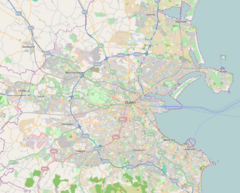
Sir William Chambers was a Swedish-Scottish architect, based in London. Among his best-known works are Somerset House, and the pagoda at Kew. Chambers was a founder member of the Royal Academy.

In architecture, a folly is a building constructed primarily for decoration, but suggesting through its appearance some other purpose, or of such extravagant appearance that it transcends the range of usual garden buildings.

James Caulfeild, 1st Earl of Charlemont KP PC (Ire), was an Irish statesman.

Rathmines is an affluent inner suburb on the Southside of Dublin in Ireland. It begins at the southern side of the Grand Canal and stretches along the Rathmines Road as far as Rathgar to the south, Ranelagh to the east, and Harold's Cross to the west. It is situated in the city's D06 postal district.
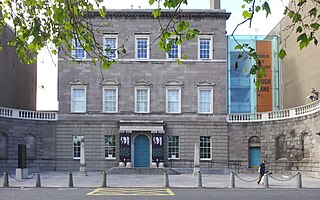
Charlemont House is a mansion in Dublin, Ireland. The house was built in 1763 and designed by William Chambers for James Caulfeild, the 1st Earl of Charlemont. It is a stone fronted mansion on Dublin's Parnell Square. It was purchased by the government in 1870 and since 1933 it has housed the Hugh Lane Dublin City Gallery.

Fairview is an inner coastal suburb of Dublin in Ireland, in the jurisdiction of Dublin City Council and in the city's D03 postal district. Part of the area forms Fairview Park, a recreational amenity laid out on land reclaimed from the sea.

The Casino at Marino is a small summer or pleasure house, located in Marino, Dublin, Ireland. Sometimes erroneously described as a folly, it was designed by Scottish architect William Chambers for James Caulfeild, the 1st Earl of Charlemont, starting in the late 1750s and finishing around 1775. It is a good example of Neo-Classical architecture, situated in the gardens of Marino House. Although proud of the design, Chambers was never able to visit the completed building, as he was constantly employed in England.

The Dunmore Pineapple is a folly in Dunmore Park, near Airth in Stirlingshire, Scotland. In 1995 it was ranked "as the most bizarre building in Scotland".
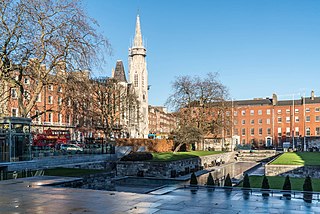
Parnell Square is a Georgian square sited at the northern end of O'Connell Street in the city of Dublin, Ireland. It is in the city's D01 postal district.
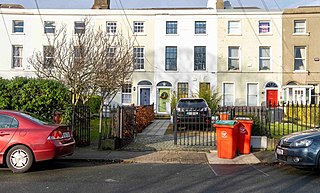
Marino is an inner suburb on the Northside of Dublin, Ireland. It was built, in a planned form, on former grounds of Marino House, in an area between Drumcondra, Donnycarney, Clontarf, and what became Fairview. The initial development featured around 1,300 concrete-built houses.
St Vincents is a Gaelic Athletic Association club based in Marino, on the northside of Dublin, Ireland. The club was founded in 1931 in Marino, instrumental in the founding of the club were Rev Dr William Fitzpatrick and Bro. Ernest Fitzgerald. Although its club grounds were in Raheny for a number of years, it moved to its home back into Marino in 1987. St Vincents merged with Marino Camogie Club in 1997 to form the St. Vincents Hurling, Football and Camogie Club. They have won the All-Ireland Senior Club Football Championship on three occasions, most recently in 2014. They are the most successful side in the Dublin Senior Football championship having won the title 29 times. The club has also won 15 Dublin Senior 1 camogie titles and completed a three in a row in 2015–2017.

The O'Brien Institute is a building complex off the Malahide Road, near Mount Temple Comprehensive School in Marino, Dublin, Ireland. Built in 1880–1883 as an orphan home and school, the purchase of the land, and building costs, were financed by a trust that was founded by the will of Bridget O'Brien in 1876. The last four boarders left in 1976, when the school, which was run by the Irish Christian Brothers, closed. The institute was bought by Dublin Corporation, and is currently primarily used by Dublin Fire Brigade as a training centre, while the educational trust continues within the Archdiocese of Dublin.

Emo Court, located near the village of Emo in County Laois, Ireland, is a large neo-classical mansion. Architectural features of the building include sash-style windows, pavilions, a balustrade, a hipped roof, and large dome.
Donnycarney is a Northside suburb in the city of Dublin, Ireland, in the jurisdiction of Dublin City Council. It is mostly residential, around 5 kilometres (3.1 mi) from the centre of Dublin. Dublin GAA's home stadium, Parnell Park, is located here.

The Monroe Avenue Commercial Buildings, also known as the Monroe Block, is a historic district located along a block-and-a-half stretch at 16-118 Monroe Avenue in Detroit, Michigan, just off Woodward Avenue at the northern end of Campus Martius. The district was designated a Michigan State Historic Site in 1974 and listed on the National Register of Historic Places in 1975. The thirteen original buildings were built between 1852 and 1911 and ranged from two to five stories in height. The National Theatre, built in 1911, was the oldest surviving theatre in Detroit, a part of the city's original theatre district of the late 19th century, and the sole surviving structure from the original Monroe Avenue Commercial Buildings historic period.

Balcarres House lies 1km north of the village of Colinsburgh, in the East Neuk of Fife, in eastern Scotland. It is centred on a mansion built in 1595 by John Lindsay (1552–1598), second son of David, 9th Earl of Crawford. The house became the family seat of the Earl of Crawford. The present house is the result of substantial extensions in the early nineteenth century, using part of a fortune made in India, but preserves much of the original mansion.
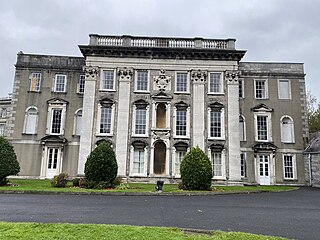
Drumcondra House is a Georgian house and gardens in Drumcondra, Dublin, Ireland which as of 2022 forms part of the DCU All Hallows Campus and formerly part of All Hallows College. It was designed by the architects Sir Edward Lovett Pearce and Alessandro Galilei and was built in 1726 for Marmaduke Coghill who had originally lived in Belvidere House, and now forms part of DCU St. Patrick's Campus Drumcondra.
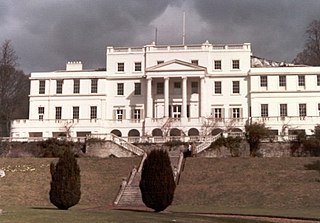
Linton Park, formerly Linton Place or Linton Hall, is a large 18th-century country house in Linton, Kent, England. Built by Robert Mann in 1730 to replace a much earlier building called 'Capell's Court', the estate passed through the ownership of several members of Mann's family before coming into the Cornwallis family. The house was enlarged to its current size in 1825.

Aldborough House is a large Georgian house in Dublin, Ireland. Built as a private residence by 1795, the original structure included a chapel and a theatre wing.

Marino Crescent is a Georgian crescent of 26 houses at the junction of Marino, Fairview and Clontarf in Dublin 3, Ireland. It is the only Georgian crescent in Dublin.

